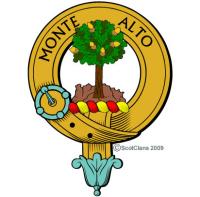
Clan Mouat
The surname Mouat, also seen spelled Mouatt, Mowat, Mowatt, is a name of Norman origin, Mont Hault, or in Latin Monte Alto, meaning 'of the high mount'.
It was in Wales where the Monte Altos first settled, and where Mold is a shortened version of their territorial name.
Robert Montealto is the first of this name to be recorded in Scotland, at some point during the reign of David I, and it is believed that he came up from Wales.
During the reign of William the Lion, the family rose into some notable power, acquiring lands in Angus, and including the lordship of Fern of Ferne.
A charter by William Cumin, Earl of Buchan, of half a mark of silver of the ferm of Inuermer, was witnessed by both Robert de Muhaut and Michaele de Muhaut at some point between 1210 and 1233.
In 12119, a William de Monte Alto witnessed a preambulation of the marches of Arbroath Abbey and those of Kynblathmund.
Between 1198 and 1218, Alexander de Mohaut appears often as a charter witness in the chartularies of Arbroath and Brechin. His surname is seen written in a number of different ways, including Mouhat, Mouhaut, Muhaut, and Muhauth.
During his time as sheriff of Inverness, Michael de Monte Alto witnessed a composition between the bishop of Moray and the Earl of Mynynteth, Walter Cumyn, in regards to the lands of Kynkardyn. In 1242, Michael also witnessed a charter to Gylandris MacLod from Alexander II, and then in 1248 he witnessed a composition between Freskyn de Moravia, Lord of Duffus, and Simon, bishop of Moray, "super usuario nemoris et mores de Spyny et de Fynrossy".
In 1263, William de Monte Alto was the sheriff of Crumbathyn (now Cromarty), and in 1275 he attested an agreement between Archibald Heroch, bishop of Caithness and William de Moravia, 1st Earl of Sutherland.
Bernard de Monte Alto accompanied Princess Margaret, daughter of Alexander III, to Norway, along with the abbot of Balmurinach (Balmerino) and a number of knights. On his return, along with the abbot and many others, he drowned when the ship they were on wrecked.
William de Mahaut was one of the signers of the 1289 letter to England's Edward I concerning the propsed marriage between his eldest son, the future Edward II, and Margaret, Maid of Norway.
Seven years later, in 1296, William de Mahaut was amongst the many nobles who signed the Ragman Rolls, and thus pledged their allegiance to Edward I. By 1305, William was known as the "heritable sheriff" of Crombathyn.
Bernard de Mohaut "was sentenced to be drawn and hanged" for taking arms against the king of England at Methven (Meffen), "and feloniously slaying some of the king's liegemen there and taken on the field, and slaying Roger de Tany the king's vallet, in Selkirk forest, and burning and destroying churches in Scotland,".
In 1327, William de Montealto was killed at the seige of Norham Castle. Seven years previously he had been one of the signatories of the Scottish Declaration of Independence in 1320.
As early as around the beginning of the fifteenth century, Mowats were settled in Ayrshire, and within two years they were found within the Edinburgh area.
It is not an uncommon name, and can still be found in Caithness and the Orkneys where local pronuciation of the name is 'Mode'.
In 1410, John Mowet was prebendary of the church of Guthrie, at Aberlemno, in Angus.
One of the richest men in Norway was an Axel Mowat (1593-1661) who descended from the Mowats of Balquhally in Aberdeenshire. Axel was an admiral in the Norwegian-Danish navy.
Additional spellings of the name Mouat from over the years include Meuatt, Mohuat, Mout, Movat, Mowait, Mowaite, Mowit, and Mwat.




